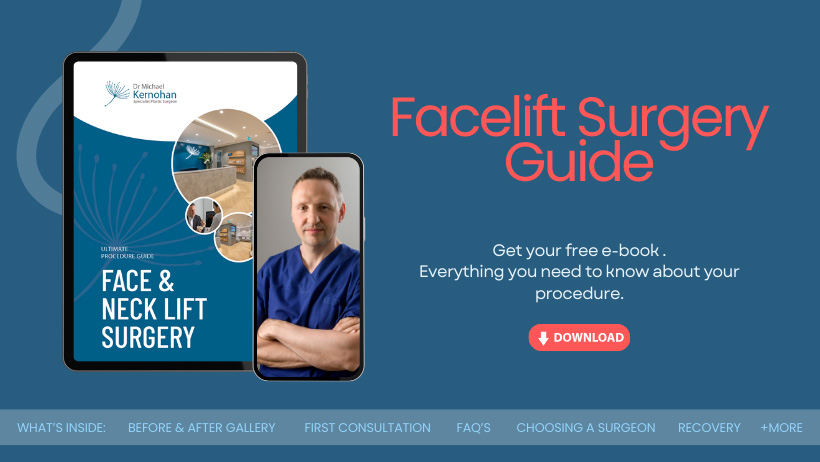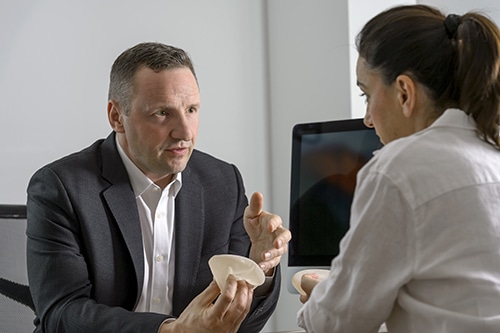Facelift Surgery – How to Handle Potential Complications
As you consider facelift surgery, it’s important to understand both the benefits and potential challenges that may arise. While facelift surgery can have an impact on your appearance, it’s important to be aware of common issues such as haematoma formation and wound healing complications.
In this blog, Sydney Specialist Plastic Surgeon Dr Michael Kernohan will explore the most frequent complications associated with facelift surgery and provide you with valuable insights on how to prevent and manage them. You’ll learn about essential pre-operative preparations, steps to take during recovery, and strategies to handle unexpected issues.
Are You Ready for Surgery? Find Out
Common Complications after Facelift Surgery
By being aware of the complications associated with facelift surgery, you can better prepare for your procedure and take steps to minimise risks. Let’s explore some of the most common complications you might encounter after facelift surgery:
- Haematoma
Haematoma is one of the most frequent complication after a facelift. It occurs when blood collects under the skin, forming a pocket. Studies have shown that the incidence of expanding haematoma following a facelift is around 1.8% to 1.97%.
Several factors can increase your risk of developing a haematoma:
- High blood pressure: If your systolic blood pressure is above 150 mm Hg, you’re 3.6 times more likely to develop a haematoma.
- Gender: Men have a 2.8 times higher risk than women.
- Medication use: Taking aspirin or NSAIDs can double your risk.
- Smoking: This habit also doubles your chances of haematoma formation.
To reduce the risk of haematoma, your surgeon may implement strict blood pressure control before, during, and after the procedure. They might also use drains to prevent blood accumulation in the surgical area.
- Skin Necrosis
Skin necrosis, though rare, can be a serious complication. It occurs when the blood supply to the skin is compromised, leading to tissue death. Smoking is the most significant risk factor for skin necrosis. In other words, if you smoke, you’re more likely to experience necrosis after surgery. Other factors that can contribute to skin necrosis include:
- Thin skin flaps
- Excessive tension on the skin
- Undrained haematoma
- Wide skin undermining beyond the nasolabial folds
To lessen the risk of skin necrosis, it’s important to stop smoking at least 2-4 weeks before and after surgery. Your surgeon may also use techniques that preserve blood supply to the skin flaps and avoid excessive tension during the procedure.
- Nerve Injury
Nerve damage, while uncommon, can occur during facelift surgery. The facial nerve is particularly vulnerable, and injury can lead to various symptoms depending on the severity and location of the damage. These may include:
- Pain or numbness in parts of the face
- Weakness or partial paralysis of facial muscles
- Difficulty closing the eyes or smiling
- Drooping eyelids or corners of the mouth
- Asymmetrical facial appearance
In most cases, nerve damage is temporary and resolves on its own. However, in rare instances, it may be permanent. If nerve damage occurs, treatment options may include medication, neuromodulator injections, physical therapy, or in severe cases, specialised surgery.
- Infection
Surgical site infections following facelift surgery are relatively rare, with a low incidence rate. Most infections are caused by Staphylococcus species, including methicillin-resistant Staphylococcus aureus (MRSA).
To prevent infections, your surgeon will likely:
- Use strict sterile techniques during surgery
- Administer intravenous prophylactic antibiotics before and after the procedure
- Irrigate the operative field with antibiotic solution
- Prescribe postoperative antibiotics
You can also help reduce the risk of infection by following your surgeon’s post-operative care instructions carefully and maintaining good hygiene during recovery.
By understanding these common complications and taking appropriate precautions, you can significantly improve your chances of a smooth recovery and optimal results from your facelift surgery. Always discuss any concerns with your surgeon and follow their advice closely to ensure the best possible outcome.
Download Dr Kernohan’s Face and Neck Lift Surgery Guide

Preventing Complications during Facelift Surgery
To ensure an optimal outcome from your facelift surgery, your plastic surgeon will take steps to prevent complications.
Patient Selection
Being a suitable candidate for facelift is essential to minimising risks. Your surgeon will assess your candidacy for the procedure based on several factors:
- Age: While most facelift patients are over 50, and some are over 65, age alone doesn’t disqualify you. With proper screening, even older patients can undergo facelift surgery with relatively low risk.
- Medical conditions: Certain health issues may increase your risk of complications. These include poorly controlled diabetes, high blood pressure and conditions that prevent blood clotting.
- Medications: Blood-thinning medications or supplements can increase the risk of haematomas. You’ll likely be asked to stop taking these at least two weeks before surgery. These include: Aspirin, NSAIDs, Ginseng, Ginkgo biloba, fish oil.
- Smoking: Active smoking significantly increases the risk of skin necrosis. Your surgeon may advise quitting smoking well before the procedure.
- Weight stability: A history of repeated weight changes may affect your long-term satisfaction with the results.
Surgical Technique
The choice of surgical technique can significantly impact the risk of complications. Here are some key points:
- Deep-plane technique: This approach has shown to reduce the incidence of skin necrosis.
- Limited skin flap dissection: Decreasing the amount of skin flap dissection can lower the risk of wound healing issues. However, patients with deep nasolabial folds may require more extensive undermining, which increases the risk of skin necrosis.
- Tension management: Excessive tension on the incision can lead to hypertrophic scars or necrosis. There should be no tension on the retro auricular closure.
- Blood pressure control: Strict perioperative blood pressure control has been shown to reduce haematoma incidence, especially in male patients.
Postoperative Care
Proper care after your facelift surgery is important to prevent complications and ensure optimal healing. Here’s what you can expect:
| Care Stage | Details |
| Immediate Post-Surgery Care | – Incisions covered with bandages to minimize swelling and bruising. – Possible drainage tube behind ears to remove excess blood or fluid. – Need someone to drive you home and assist on the first night after surgery. |
| First Few Days After Surgery | – Rest with your head elevated. – Take pain medication as recommended. – Apply cool packs to your face to reduce pain and swelling. |
| Follow-up Appointments | – Several check-ups within two months post-surgery. – Drainage tube likely removed, and bandages changed the day after surgery. – Stitches typically removed about a week after surgery. |
| Self-Care at Home | – Follow wound care instructions from your surgeon. – Avoid picking at scabs on your wound. – Use gentle shampoos and soaps as directed. – Wear front-fastening clothes to avoid pulling garments over your head. – Avoid makeup and hair treatments for several weeks. – Protect incisions from direct sun exposure and use SPF 30 or higher sunscreen. |
Managing Facelift Complications When They Occur
Despite taking precautions, complications can still occur after facelift surgery. Knowing how to handle these issues promptly and effectively is essential for your recovery and overall satisfaction with the procedure.
Early Recognition
Being vigilant in monitoring your skin’s response after surgery is essential to identify potential complications early. You may notice some common issues, such as rashes, which can occur due to the drying effect of skin preparations used during the procedure. It’s important to pay attention to any changes in your skin, including increased redness, swelling, or persistent discomfort. These signs warrant immediate attention from your surgeon.
To help you recognise potential complications, here are some points to keep in mind:
- Monitor your face and neck closely for any unusual changes.
- Be aware of any severe pain, especially if it’s concentrated on one side of your face or neck within 24 hours of surgery.
- Watch for signs of haematoma formation, which typically occurs within the first 24 hours after surgery.
- Pay attention to any facial asymmetry or difficulty moving facial muscles.
Prompt Treatment
When complications are identified, prompt treatment can help prevent further issues and ensure a smooth recovery. Here’s how different complications are typically managed:
- Haematoma: If a haematoma forms, your surgeon will likely recommend returning to the operating room for proper evacuation, exploration, and identification of bleeding areas.
- Skin necrosis: If you experience questionable skin viability without an underlying identifiable cause, your surgeon will likely treat it conservatively. The depth of tissue injury will determine the choice of dressings. Most cases heal spontaneously with proper wound care, and secondary scar revision can be performed later if necessary.
- Nerve dysfunction: Temporary nerve dysfunction and facial asymmetry immediately following the facelift may occur due to residual effects of local anaesthetic, which typically dissipates within hours. Persistent dysfunction should resolve within 3 to 4 months.
- Skin loss: In rare cases where blood supply to facial tissues is interrupted, resulting in skin loss, treatment involves medications and appropriate wound care. If necessary, a procedure may be performed to reduce scarring.
Patient Communication
Open and honest communication with your surgeon is vital throughout your recovery process. Here are some guidelines to help you communicate effectively:
- Report any concerns or unusual symptoms to your surgeon immediately.
- Attend all scheduled follow-up appointments to allow your surgeon to monitor your progress.
- Be prepared for several check-ups in the two months following surgery.
Remember, your surgeon is your best resource for addressing any complications or concerns. Don’t hesitate to reach out if you experience severe pain, chest pain, or irregular heartbeats, as these symptoms require immediate medical attention.
FAQs about Facelift Complications

What is the most frequent complication following a facelift?
- The most frequent complication after a facelift is a haematoma, which is a collection of blood under the skin. This can cause swelling and pressure, typically occurring within the first 24 hours after the procedure. In some cases, surgical intervention is necessary to prevent damage to the skin and surrounding tissues.
How often do facelifts result in complications?
- Facelifts have a complication rate of about 1.8%, which is comparable to the 2% rate seen in other cosmetic surgeries. The most common issues are haematomas, which occur in 1.1% of cases, and infections, which occur in 0.3% of cases.
What are the signs of a poorly done facelift?
- A facelift that results in an overly tightened appearance can cause several issues. If the skin is pulled too much upwards, it might lead to bunched-up skin around the lower eyelids or a reduced space between the eyelids. Conversely, if the skin is pulled too laterally, the face can appear ‘wind-swept’, distorting the mouth’s corners.
What you should and shouldn’t do after a facelift?
After a facelift, it’s important to follow these guidelines:
- Do: Protect your skin from sun exposure.
- Do: Prepare to sleep in a propped-up position.
- Do: Arrange for assistance during your recovery.
- Do: Maintain a healthy diet and stay hydrated.
- Do: Be patient with your healing process.
- Don’t: Engage in strenuous activities.
- Don’t: Irritate your facial area.
- Don’t: Use hair products near the face.
Further Reading about Facelift Surgery with Sydney Specialist Plastic Surgeon Dr Michael Kernohan
- Read Dr Kernohan’s Blog about SMAS vs Deep Plane Facelift
- Read Dr Kernohan’s Blog about What is a Ponytail Facelift?
- Read Dr Kernohan’s Blog about Recovery after Facelift Surgery Sydney
- Read Dr Kernohan’s Blog about How to Sleep after a Facelift
- Read Dr Kernohan’s Blog about How to Find the Best Facelift Surgeon in Sydney
Medical References for Facelift Surgery Complications
- Facial Skin Necrosis after Facelift Surgery
- Methods for Minimizing Bleeding in Facelift Surgery: An Evidence-based Review
- Evolution of Superficial Muscular Aponeurotic System Facelift Techniques: A Comprehensive Systematic Review of Complications and Outcomes
- Evaluating Facelift Complications and the Effectiveness of the SMASectomy Technique
- Facelift complications and the risk of venous thromboembolism: a single center’s experience





